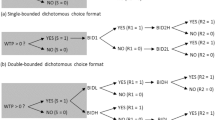Abstract
This paper explores two commonly used methods to elicit an individual's willingness to pay (WTP) for a public good in contingent valuation studies. Currently, the most preferred method is the “take-it-or-leave” valuation question, or discrete valuation question (DVQ), where the respondent accepts or rejects a suggested cost for the good. The traditional method, the continuous valuation question (CVQ), simply asks an individual to state his WTP for the suggested change in the provision of a public good like cleaner air. We introduce a simple way to compare the results from these two methods. We also test the anchoring behavior suggested in the psychological literature on choice under uncertainty. The results do not support the anchoring hypothesis, but suggest the hypothesis that people perceive the two tested valuation questions differently.
Similar content being viewed by others
References
Ayer, M., H. D., Brunk, G. M., Ewing, and E., Silverman (1955), ‘An Empirical Distribution Function for Sampling with Incomplete Information’, Annals of Mathematical Statistics 26, 641–647.
Bishop, R. C. and T. A. Heberlein (Undated), ‘The Contingent Valuation Method’, Mimeo. Department of Agricultural Economics, University of Wisconsin, Madison.
Fisz, M. (1963), Probability Theory and Mathematical Statistics, Wiley, New York.
Hoehn, J. P. and A., Randall (1987), ‘A Satisfactory Benefit Cost Indicator from Contingent Valuation’, Journal of Environmental Economics 14, 226–247.
Kahnemann, D., P., Slovic, and A., Tversky (1982), Judgment Under Uncertainty: Heuristics and Biases, Cambridge University Press, New York.
Kealy, M. J., J. F., Dovidio, and M. L., Rochel (1988), ‘Accuracy in Valuation Is a Matter of Degree’, Land Economics 65, 158–171.
Kriström, B. (1990a), ‘Valuing Environmental Benefits Using the Contingent Valuation Method: An Econometric Analysis’, Diss. Umeå economic studies, 219, 1990.
Kriström, B. (1990b), ‘A Non-Parametric Approach to the Estimation of Welfare Measures in Discrete Response Valuation Studies’, Land Economics 66(2), 135–139.
Lindgren, B.W. (1969), Statistical Theory, MacMillan, Toronto.
Petitt, A. N. and M. A., Stevens (1977), ‘The Kolmogorov-Smirnov Goodness-of-Fit Statistics for Discrete and Grouped Data’, Technometrics 19, 205–210.
Sellar, C., J. R., Stoll, and Chavas, J.-P. (1985), ‘Validation of Empirical Measures of Welfare Change: A Comparison of Nonmarket Techniques’, Land Economics 61, 156–175.
Shiryayev, S. (1984), Probability, Springer-Verlag, New York.
Walsh, R. G., D. M., Johnson, and J. R., McKean (1989a), ‘Issues in Nonmarket Valuation and Policy Application: A Retrospective Glance’, Western Journal of Agricultural Economics 14(1), 178–188.
Author information
Authors and Affiliations
Additional information
I would like to thank Prof. Glenn Harrison, University of South Carolina, Prof. P-O Johansson, Stockholm School of Economics, Prof. Jason Shogren, Iowa State University, and two referees for helpful comments. The usual disclaimer applies.
Rights and permissions
About this article
Cite this article
Kriström, B. Comparing continuous and discrete contingent valuation questions. Environmental and Resource Economics 3, 63–71 (1993). https://doi.org/10.1007/BF00338320
Issue Date:
DOI: https://doi.org/10.1007/BF00338320




